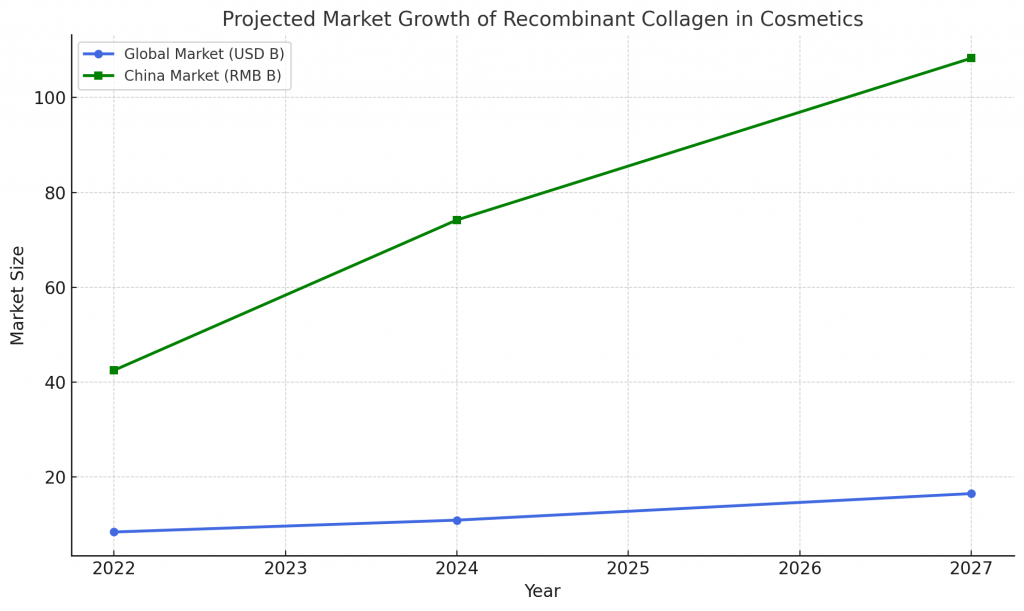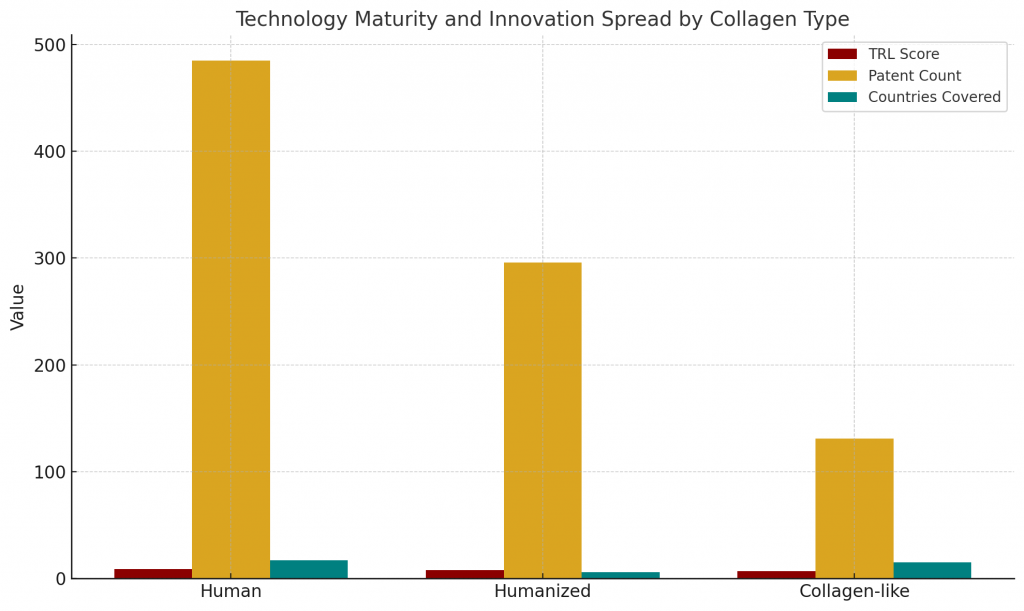What Is Recombinant Collagen and Why Is It Changing the Cosmetics Industry?
The beauty world is witnessing a transformative shift with the rise of recombinant collagen in cosmetics. Unlike traditional collagen sourced from animals, recombinant collagen is created through biotechnology—a process that uses genetically engineered microorganisms to produce pure, high-quality collagen. This innovation is not only vegan and cruelty-free but also offers better stability, efficacy, and safety for sensitive skin.
With a growing demand for sustainable beauty ingredients and biotech skincare solutions, recombinant collagen is becoming a star player in the anti-aging, hydration, and regenerative skincare space.
How Is Recombinant Collagen Produced?
Recombinant collagen is synthesized using a process known as gene cloning. Scientists insert human collagen genes into host organisms such as yeast, bacteria, or even plants. These engineered organisms then produce collagen in controlled environments, ensuring high purity, batch consistency, and non-animal origin.
This synthetic process solves many issues associated with animal-derived collagen, such as:
- Risk of disease transmission
- Allergenic responses
- Ethical and environmental concerns
It also enables customizable collagen peptides, making it ideal for advanced formulations and medical-grade skincare.
Why Is Vegan Collagen Better Than Animal-Derived Collagen?
Traditional collagen often comes from bovine, marine, or porcine sources. While effective, these forms can trigger allergies, ethical debates, and environmental scrutiny. In contrast, recombinant collagen in cosmetics provides several clear advantages:
| Feature | Animal Collagen | Recombinant Collagen |
| Source | Bovine/Fish/Pig | Yeast/Bacteria |
| Allergen Risk | Moderate–High | Low |
| Purity | Variable | High |
| Customization | Limited | High |
| Ethical & Vegan | ❌ | ✅ |
| Consistency | Variable | Consistent |
This makes recombinant collagen a safer, cleaner, and future-proof option for brands and consumers alike.
Where Is Recombinant Collagen Used in Cosmetics?
The applications of recombinant collagen in cosmetics are growing rapidly. Skincare brands are embracing this innovation for multiple formulations, including:
- Anti-aging serums & creams
- Hydrating moisturizers & masks
- Post-treatment skin repair solutions
- Scalp & hair-strengthening products
- Injectables and microneedle patches
These products benefit from the bioactive peptides and skin barrier restoration capabilities of recombinant collagen, which outperforms many synthetic actives currently in the market
What Is the Market Demand for Recombinant Collagen?

The global demand for recombinant collagen in cosmetics is exploding due to a shift toward clean, vegan, and effective beauty products.
Global Market Forecast:
- Expected to reach $16.5 billion by 2030
- CAGR of 15% from 2024–2030
- China alone is forecasted to reach ¥108.3 billion (~$15.2B) by 2027
This surge is driven by:
- The rise in vegan collagen skincare
- Growing interest in cosmeceuticals and functional ingredients
- Strategic R&D investments by leading companies
Which Companies Are Leading This Revolution?
Mature Brands:
- L’Oréal – Uses recombinant collagen in their Age Perfect Collagène Royal line
- Geltor – Makers of HumaColl™21, a key ingredient in vegan skincare
- CollPlant – Supplies collagen for dermal fillers and medical applications
- Bloomage Biotech – Leading the Chinese market with award-winning formulations
- Trautec – High-purity collagen for injectables and dermo-cosmetics
Startups to Watch:
- KEFUMEI – Serum-focused collagen innovations
- Sador – Peptide-based anti-aging solutions
- Marubi – Dry spinning and microneedle patch collagen delivery
These companies are not only meeting consumer demand but shaping the future of biotech in beauty.
Which Countries Are Investing in Recombinant Collagen?
China, the U.S., Japan, and South Korea are the top patent holders in this space. Over 900 patents have been filed across three major collagen types:
| Collagen Type | TRL (Tech Maturity) | Patent Count | Countries Active |
| Human | 9 | 485 | 17 |
| Humanized | 8 | 296 | 6 |
| Collagen-like Proteins | 7 | 131 | 15 |
China leads in both research and commercialization, while the U.S. and Europe focus on medical-grade and luxury applications.

What Role Do Research Institutions and Labs Play?
Top universities and biotech labs are pioneering advanced forms of synthetic collagen, including:
- Fudan University – Collagen fiber engineering
- Lanzhou University – Biomedical collagen innovation
- Wake Forest Institute for Regenerative Medicine – Collagen scaffolding
- PTRME & PlantForm – Funded partnerships for collagen fibers
These collaborations are laying the groundwork for AI-driven skincare personalization and next-gen cosmetic delivery systems.
Are There Regulations for Recombinant Collagen in Cosmetics?
Yes. The regulatory landscape is evolving to support this innovation.
Key Guidelines:
- NMPA (China) – Classifies injectable collagen as a Class III medical device
- EU MDR – Covers dermal fillers under medical device regulations
- ISO 13485:2016 – Ensures manufacturing quality for medical-grade collagen
- YY/T 1849-2022 – China’s specialized standard for recombinant collagen
This framework enables safe scaling, especially for cosmeceuticals and cross-border markets.
What Are the Sustainability Benefits?
Using recombinant collagen in cosmetics contributes to:
- Reduced animal exploitation
- Lower carbon footprint compared to animal farming
- Minimal use of water and land resources
- Safe and sterile lab-grown production
It perfectly aligns with the principles of green chemistry, eco-beauty, and ESG compliance.
How Is AI Enhancing Recombinant Collagen Formulations?
Several beauty tech firms are integrating AI and machine learning to optimize:
- Collagen peptide sequencing
- Custom skincare formulation
- Real-time skin analysis and product matching
This intersection of biotech and digital personalization is set to become a core driver of cosmetic innovation.
How PatentsKart Can Help You with Recombinant Collagen Innovation
At PatentsKart, we specialize in navigating the complex world of intellectual property in emerging technologies—including recombinant collagen.
Here’s how we can help:
- Patent Landscape Reports: Track who’s innovating and where
- Competitive Benchmarking: Compare biotech skincare players
- Market & IP Strategy Consulting: Align R&D with monetization goals
- Tech Scouting & Licensing: Identify acquisition or collaboration opportunities
- FTO & Regulatory Mapping: Minimize risk, ensure compliance
Whether you’re a formulation lab, beauty brand, investor, or R&D firm, we deliver actionable IP insights to keep you ahead of the curve.
FAQ
-
What is recombinant collagen and how is it used in cosmetics?
Recombinant collagen is a lab-engineered version of collagen created using biotechnology, where human collagen genes are inserted into microorganisms like yeast or bacteria. In cosmetics, it is used in anti-aging creams, hydrating serums, and regenerative skincare due to its high purity, vegan origin, and superior skin compatibility.
-
Is recombinant collagen better than animal-derived collagen for skincare?
Yes, recombinant collagen in cosmetics offers several advantages over animal-derived collagen. It is vegan, ethically produced, has lower allergenic potential, and offers better consistency and customization. This makes it safer and more sustainable for long-term skincare use.
-
What are the benefits of using recombinant collagen in cosmetics?
Key benefits include improved skin hydration, anti-aging effects, enhanced skin elasticity, faster post-treatment recovery, and reduced environmental impact. Recombinant collagen is also ideal for sensitive skin as it eliminates risks associated with animal-based collagen.
-
Which skincare brands use recombinant collagen?
Leading brands using recombinant collagen in cosmetics include L’Oréal, Geltor (HumaColl™21), Bloomage, Trautec, and startups like KEFUMEI and Sador. These brands use it in serums, moisturizers, microneedle patches, and even injectable-grade formulations.
-
Is recombinant collagen safe and approved for cosmetic use?
Yes, recombinant collagen is considered safe for cosmetic use and is regulated by authorities like China’s NMPA and the EU MDR. Standards such as ISO 13485:2016 and YY/T 1849-2022 ensure quality and safety, especially for medical-grade and injectable applications.
Recent Blogs You Should Check Out
- What Are Green Chemicals and Why Are They Important for a Sustainable Future?
- Smart Ring Technology: The Future of Wearable Healthcare
- What Is Marine Power Technology? A Powerful Solution for Ocean-Based Renewable Energy in 2025
- 7 Powerful Reasons Why Space-Based Solar Power Could Transform Global Energy Forever
Conclusion: Why Recombinant Collagen Is the Future of Skincare
The shift toward recombinant collagen in cosmetics signals a new era in skincare—one where science, sustainability, and performance converge. This technology not only delivers ethical and effective alternatives to animal collagen but also opens doors to next-gen beauty products, medical aesthetics, and biotech-based personalization.
With consumers demanding more transparency, and brands looking to innovate, the adoption of recombinant collagen is not just a trend—it’s a necessity.
To stay ahead of this curve, partner with experts who understand both the science and the strategy.
Visit www.patentskart.com or contact us at info@patentskart.com to explore how we can support your journey into the future of cosmetics.







